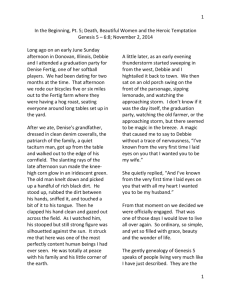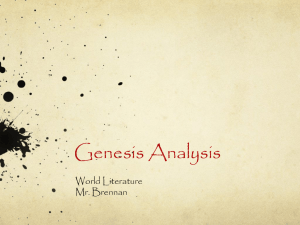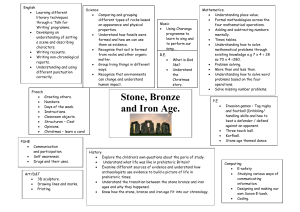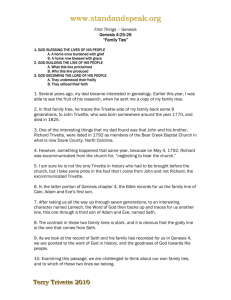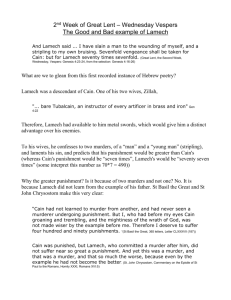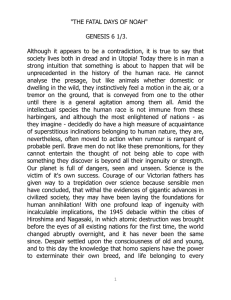Robert Vannoy, Old Testament History, Lecture 13
advertisement
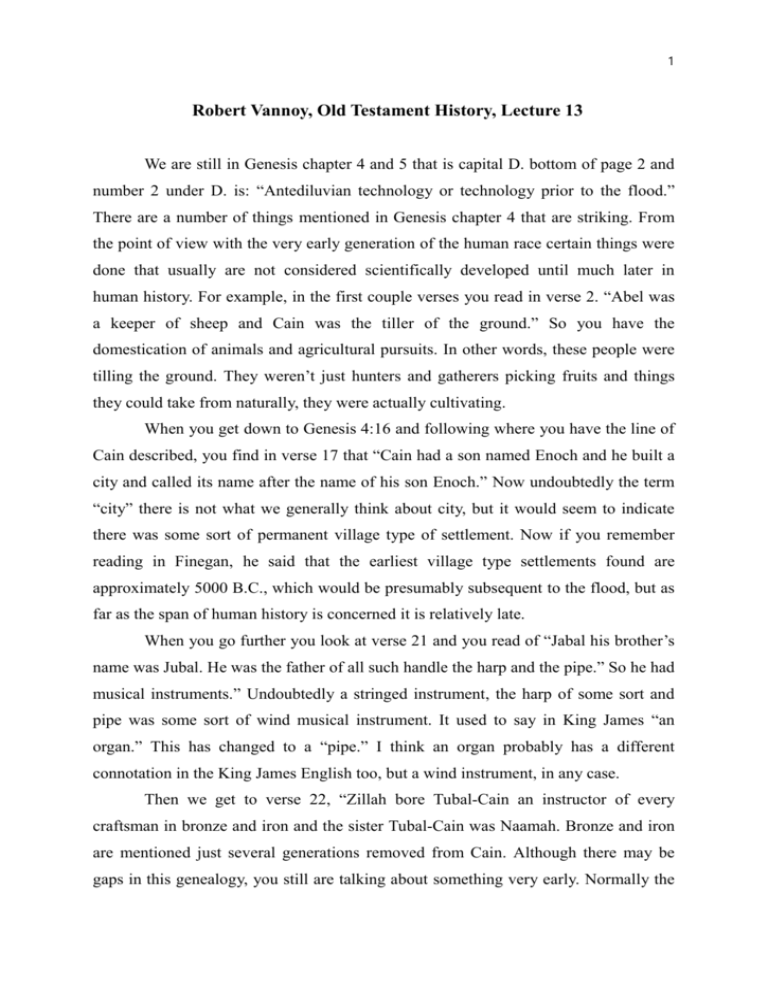
1 Robert Vannoy, Old Testament History, Lecture 13 We are still in Genesis chapter 4 and 5 that is capital D. bottom of page 2 and number 2 under D. is: “Antediluvian technology or technology prior to the flood.” There are a number of things mentioned in Genesis chapter 4 that are striking. From the point of view with the very early generation of the human race certain things were done that usually are not considered scientifically developed until much later in human history. For example, in the first couple verses you read in verse 2. “Abel was a keeper of sheep and Cain was the tiller of the ground.” So you have the domestication of animals and agricultural pursuits. In other words, these people were tilling the ground. They weren’t just hunters and gatherers picking fruits and things they could take from naturally, they were actually cultivating. When you get down to Genesis 4:16 and following where you have the line of Cain described, you find in verse 17 that “Cain had a son named Enoch and he built a city and called its name after the name of his son Enoch.” Now undoubtedly the term “city” there is not what we generally think about city, but it would seem to indicate there was some sort of permanent village type of settlement. Now if you remember reading in Finegan, he said that the earliest village type settlements found are approximately 5000 B.C., which would be presumably subsequent to the flood, but as far as the span of human history is concerned it is relatively late. When you go further you look at verse 21 and you read of “Jabal his brother’s name was Jubal. He was the father of all such handle the harp and the pipe.” So he had musical instruments.” Undoubtedly a stringed instrument, the harp of some sort and pipe was some sort of wind musical instrument. It used to say in King James “an organ.” This has changed to a “pipe.” I think an organ probably has a different connotation in the King James English too, but a wind instrument, in any case. Then we get to verse 22, “Zillah bore Tubal-Cain an instructor of every craftsman in bronze and iron and the sister Tubal-Cain was Naamah. Bronze and iron are mentioned just several generations removed from Cain. Although there may be gaps in this genealogy, you still are talking about something very early. Normally the 2 Iron Age is set in the Middle East as beginning about 1200 BC. In fact, if you think of the history of Israel, remember the conflict between Israelites and Philistines. The Philistine had the edge over the Israelites because they had the technology of iron making and the Israelites didn’t. That’s around 1200 B.C. to 1000 B.C. that is a little bit later than this. So normally Iron Age is set about 1200 B.C. copper/bronze age about 3000 B.C. The first village settlement was about 5000 B.C. and along with that agriculture. So the question arises, this is quite remarkable for this time, where is the evidence for that among anthropologists and paleontologists? I think the only response to this is: we don’t know. We don’t know exactly where the seat of this culture was. I think what the Bible is telling us is that there was an advanced culture before the flood, even though we may not have turned up the evidence of that. The Bible is telling us if there was an advanced culture before the flood it seems that subsequent to the flood it took a long period of time before men regained some of the technology that they have had earlier on. Now the whole question of how firm some of these dates are like the beginning of the Iron Age, is a point that also can be questioned. On your bibliography, I think the bottom of page 9, there is a commentary listed there by H. Stigers page 91. Stigers is discussing on that page the bronze and iron reference there in Genesis 4 and we have the notes that say, “For the early use of iron even in the late 3rd millennium see certain references.” He says, “In Asia minor an iron dagger was recovered from the tomb of an Anatolian ruler dating from 2400 to 2200.” That’s a millennium earlier than the Iron Age is normally dated. “Even in the earlier times, Hays The Sceptor of Egypt Cambridge Mass. 1960 lists in Iron beads in remains of pre-dynastic Egypt 4000 to 3200 B.C.” So Iron beads 4000 to 3200 B.C. These may represent an imported technology of beads an independent local achievement or they may have been imported as a curiosity. Hays does not date the beads more precisely than predynastic. These two widespread occurrences of use of iron are at least a millennium or two earlier than 1200 B.C., the usual date of the beginning of Iron Age in the Middle East. This should teach us caution in making pronouncements such as, “it is impossible” to the use this or any other material. It appears that there was the use of 3 iron before the flood. So the question I think that is brought up here is something we will discuss later in more detail, and that is the fragmentary nature of archeological evidence. It is improper to draw a conclusion that a biblical statement is suspect because of lack of corroborating evidence. In other words, methodologically it is problematic. Archeological findings are so fragmentary that there could be artifacts that existed that have not been found and maybe never will be found but maybe sometime it will be. But just because you don’t have the evidence is no reason to consider a biblical statement suspect. I wanted to discuss that principle in much more detail later, but I think it applies here. We will look at that when we come into a patriarchal period when archeological evidence does begin to play a role. Alright, 3. under D. is: “The line of Cain.” You have that in verses 16 through 24 of chapter 4. I just mentioned a few verses from that section I think what you find when you read that entire section, is that humanity at this point begins to go in two directions. The two directions are what you might call, the way of Cain, and the way of Seth. You have the line of Cain mentioned here in Genesis 4:16 to 24, verse 25 tells of the birth of Seth and then on over in chapter 5 you get the line of Seth. There is a contrast between the line of Cain and the line of Seth. It’s in Cain’s line that you have these references to advances in technology in culture. You don’t have those references in Seth’s line. I don’t think that means that in Seth’s line such things weren’t accomplished, but I think it means in Seth’s line there is something else that is emphasized that is more important and that is the redemptive historical significance of Seth’s line, and the spiritual direction of his line. But it seems what happened in Cain’s line was related to technological development, a spirit of pride and self-sufficiency developed. You see that highlighted down toward the end of the passage where you read in verse 22, “Zillah bore TubalCain instructor in every craftsmen in bronze and iron. Lamech said to his wives Adah and Zillah, ‘Hear my voice; you wives of Lamech, hearken unto my speech: for I have slain a man who wounded me; a young man for hurting me. If Cain shall be avenged sevenfold, truly Lamech seventy and sevenfold’” (Genesis 4:22-23). Lamech, like 4 Cain, his statement there in verses 23 and 24 reflects a spirit of violence and recklessness apparently the ability of Tubal-Cain with bronze and iron provided them as weapons by which he felt strong enough to defy any and everyone. He expresses this spirit of vengefulness towards anyone who would give him the least affront. He put his trust in technology in the scientific advances and reflects the spirit of the world. Also notice that he has two wives this is the first reference to polygamy in Scripture. Of course, that conflicts with the ideal of monogamous marriage that we discussed in connection with Genesis 2:21 and 23. So the line of Cain is one in which the spirit of the world is quite evident. I might say in connection with the whole question of the development of culture and technology. There’s an article that I have listed in the top of page 10 in your bibliography by J. Gresham Machen. It’s called “The Christianity and Culture.” And it’s in the Banner of Truth volume 69. That is an article that is well worth reading. Just as a general orientation to the question of the relationship of Christianity to culture. He develops in there three possibilities explaining the relationship between Christianity and culture. The first is that Christianity is subordinated to culture. In other words, Christianity is a product of human culture, you might say, as other religions are. Of course, he rejects that. The second position is a withdrawal from culture in which Christians, because of the danger cultural achievements and scientific knowledge, just withdraw from it altogether. The third view he discusses and develops is, the consecration of culture and that’s the one that he supports. The Christian relationship to culture should be one where the Christian is very much involved in scientific technological advances that one consecrates to the service of God, which is the responsibility of man. So I just mentioned that article even though it’s not specifically on Genesis, it does address the general question in relation to Christianity and culture that you might want to read sometime. Let’s go on to 4. “The genealogy of Seth,” which I have already mentioned in Genesis 5. There are two sub-points there on your sheet: a. “It’s purpose and his character,” and then b. “His destiny.” What happens here is that the author, after giving you the line of Cain and climaxing it in the conduct of Lamech, a violent man, 5 goes back and picks up the line of Seth. Seth is the one who replaces Abel. We discussed the genealogy of Seth in Genesis 5 earlier when we discussed primeval chronology in general. There is no basis in Genesis 5 for constructing the chronology of time from Adam to Noah. We don’t know the length of that interval. Well, that’s all we have time for today. We’ll pick up there next time. Transcribed by Peter Kang Rough edited by Ted Hildebrandt Final edit by Rachel Ashley Re-narrated by Ted Hildebrandt

